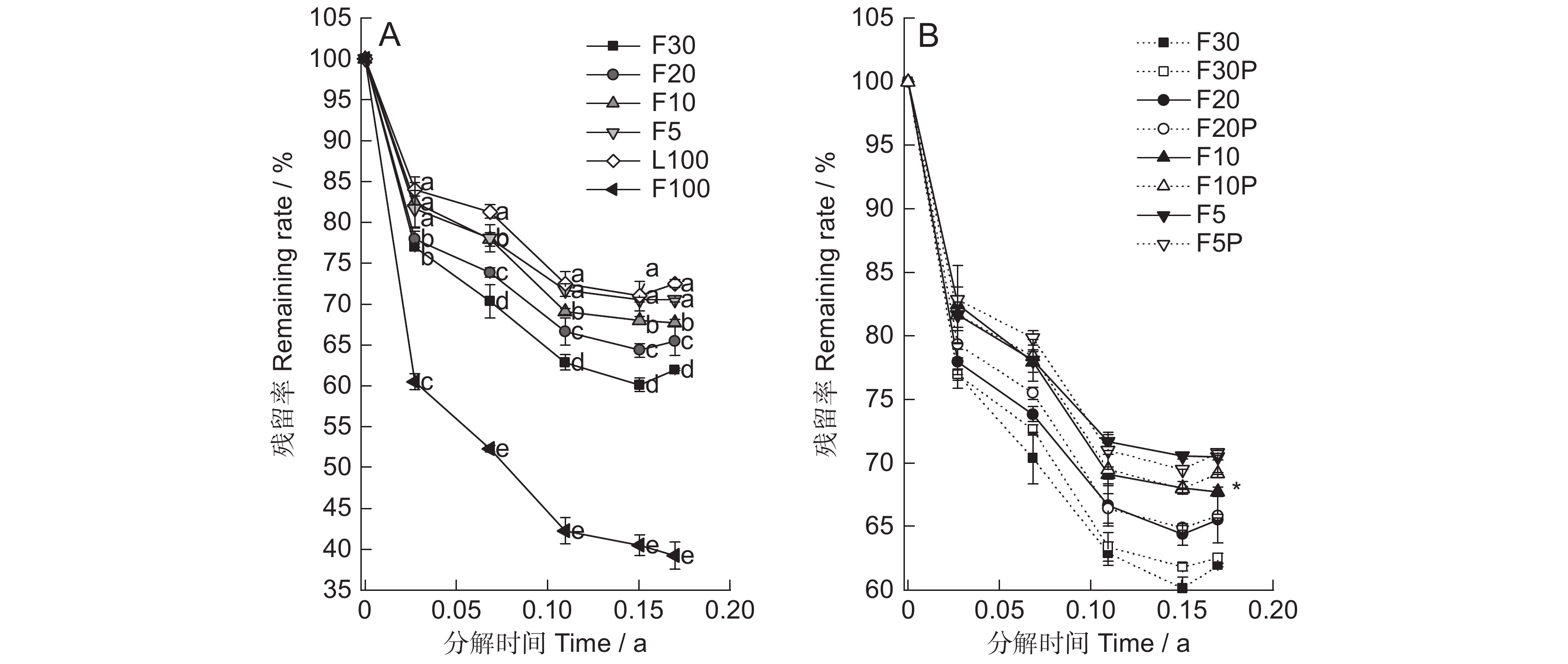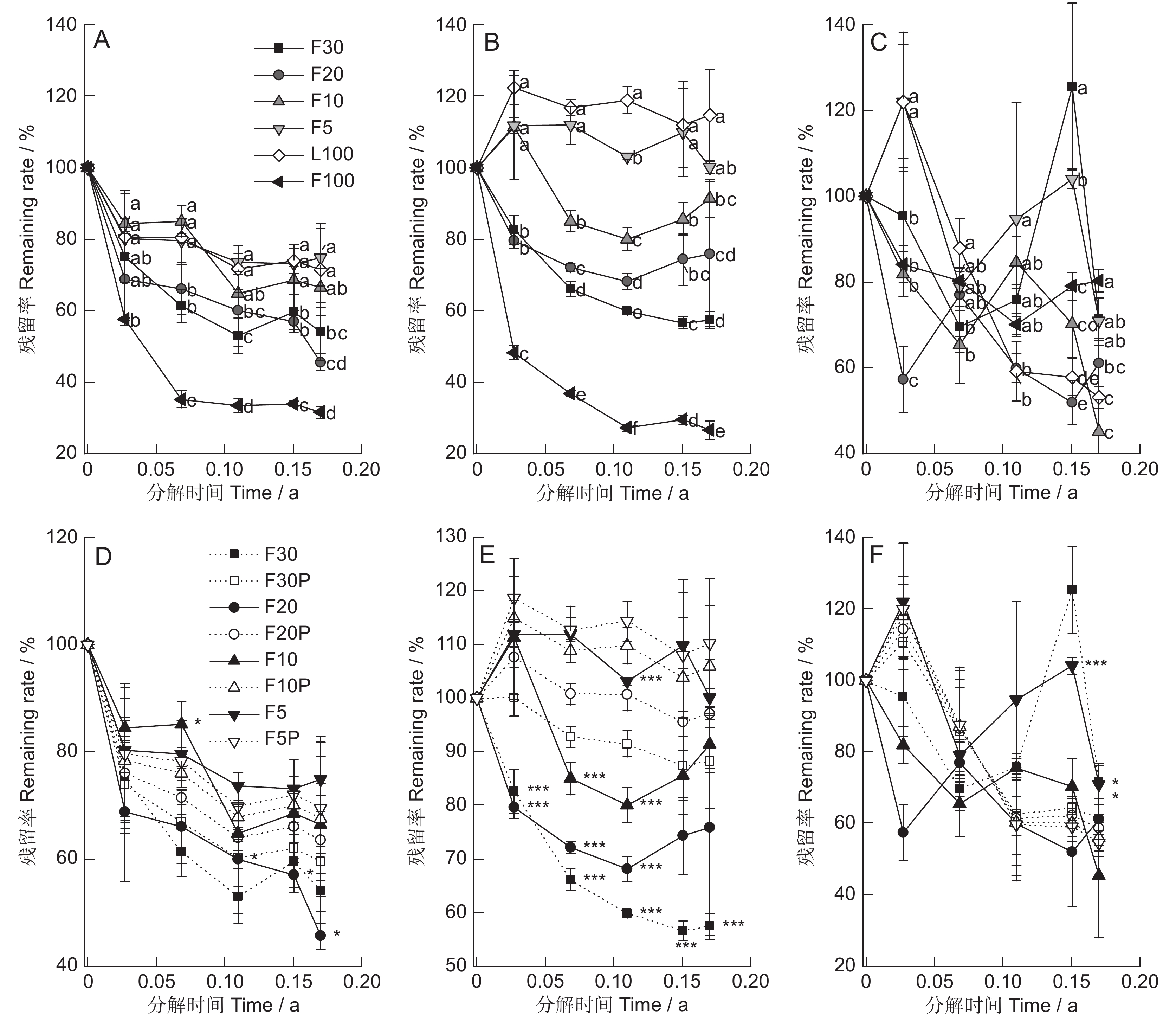Effects of fallen flower and leaf litter ratios on the decomposition of Robinia pseudoacacia L. forest litter in hilly regions of the Loess Plateau
-
摘要:
落花是森林凋落物的重要组成部分,明确其在林地凋落物混合分解中的作用有助于理解和预测林地养分的循环过程。本研究以林龄为33 a的刺槐(Robinia pseudoacacia L.)人工林产生的落花、凋落叶以及落花占比分别为30%、20%、10%和5%的花叶混合凋落物为对象,使用微生物接种法,在室内控制条件下(20℃~25℃、避光恒湿)进行为期62 d的早期分解实验,研究不同比例花叶混合凋落物的分解速率以及碳(C)、氮(N)和磷(P)释放速率的影响。结果显示:(1)落花比例达到10%时,花叶混合凋落物的分解速率显著高于纯叶凋落物,且当落花比例提高到20%~30%时,混合凋落物的分解速率再次显著提高,但花叶混合并未对凋落物的分解速率产生显著的非加和效应。(2)混合物中落花比例为10%~20%时,其C、N释放率显著高于纯凋落叶,且随落花所占比例增加,上述元素的释放呈加速趋势。实验前期高落花比例混合凋落物的P释放率普遍高于纯凋落叶或低落花比例混合凋落物,而在后期则呈相反的规律。花叶混合分解倾向于对凋落物的C和N释放产生协同促进,且该效应随落花比例的增加而增强,而对凋落物的P释放产生拮抗抑制作用,且该效应随落花比例的增加先减弱后增强。
Abstract:Fallen flowers are an important component of forest litter and clarifying their role in the mixed decomposition of forest litter is important for understanding and forecasting the nutrient cycle in forests. In the present study, fallen flowers and leaf litter produced from a 33-year Robinia pseudoacacia L. plantation were collected. Pure leaf litter and mixed litter (leaves with flowers at proportions of 30%, 20%, 10%, and 5%) were incubated for 62 d to conduct an early-stage decomposition test using soil microbial infection under controlled conditions (20℃–25℃, photophobic, constant humidity). The decomposition rate and carbon (C), nitrogen (N), and phosphorus (P) release rates of the leaf litter and flower mixtures were investigated. Results indicated that: (1) When the proportion of flowers reached 10%, the decomposition rate of the mixed litter was significantly higher than that of the pure leaf litter, and when the proportion reached 20%–30%, the decomposition rate was significantly higher again. However, the mixing of leaves and flowers did not have a significant non-additive effect on decomposition. (2) When the proportion of flowers in the mixture was 10%–20%, the C and N release rates were significantly higher than that of pure leaf litter. In addition, the C and N release rates tended to increase with an increasing proportion of flowers. During the early stages of decomposition, the P release rates tended to be significantly higher for the mixtures with higher flower proportions than those with lower flower proportions or pure leaf litter but exhibited the opposite trend with increasing decomposition. The mixed decomposition of leaf litter and flowers tended to promote C and N release synergistically, showing an increased tendency with increasing proportion of flowers. However, mixed decomposition had an antagonistic inhibitory effect on P release from litter, showing a weakened then enhanced trend with increasing proportion of flowers.
-
Keywords:
- Fallen flowers /
- Leaf litter /
- Proportions /
- Mixed decomposition /
- Non-additive effects
-
-
图 1 供试凋落物分解过程及混合分解非加和效应
A和B分别为6种凋落物的分解过程以及混合凋落物的实测和预测分解过程。F30、F20、F10和F5分别代表凋落物中落花占比为30%、20%、10%和5%,L100和F100分别代表纯凋落叶和落花,P代表混合分解的预测值。在相同分解时间下,不同字母表示凋落物间差异显著,*表示实测值和预测值间差异显著,P < 0.05。下同。
Figure 1. Decomposition of tested litter and non-additive effects of mixed decomposition
Subgraphs A and B represent decomposition progress of six types of litter and observed and predicted decomposition progress of mixed litter, respectively. F30, F20, F10, and F5 represent proportion of flowers in 30%, 20%, 10% and 5% mixed litter, respectively. L100 and F100 represent pure leaf litter or flower, respectively, while P represents predicted values in mixed litter decomposition. At the same point-in-time, different letters indicate significant differences, while * indicates significant differences between observed and predicted values, P < 0.05. Same below.
图 2 供试凋落物的养分释放过程及混合分解非加和效应
A ~ C分别为6种凋落物的碳、氮和磷的释放过程;D ~ F分别为混合凋落物碳、氮和磷的实测和预测释放过程。相同分解时间下,A ~ C中不同字母表示凋落物间差异显著,P < 0.05。D ~ F中,*和***分别表示实测值和预测值在P < 0.05和P < 0.001水平上差异显著。
Figure 2. Nutrient release of tested litter and non-additive effects of mixed decomposition
A – C represent C, N, and P release progress in six types of litter; D – F represent observed and predicted C, N, and P release progress in mixed litter. At the same point-in-time, different letters in the same column in A – C indicate significant differences, P < 0.05, while *and *** in D – F indicate significant differences between observed and predicted values at P < 0.05 and P < 0.001 level, respectively.
表 1 供试凋落物的基质质量
Table 1 Substrate quality of tested litter
凋落物
Litter碳含量
C content
/ mg/g氮含量
N content
/ mg/g磷含量
P content
/ mg/g碳氮比
C/N碳磷比
C/P氮磷比
N/P落花 546.85 ± 32.69** 71.46 ± 1.87** 2.80 ± 0.16** 7.65 ± 0.30** 195.54 ± 0.78 25.60 ± 1.00** 凋落叶 451.87 ± 22.12 22.46 ± 1.00 1.67 ± 0.25 20.12 ± 0.43 277.34 ± 29.21 13.76 ± 2.78 Note: **, P < 0.01. 表 2 基于模型预测的凋落物分解速率及混合分解非加和效应
Table 2 Olson model-based predication of litter decomposition rate and non-additive effects of mixed decomposition
凋落物类型
Litter type分解速率k
Decomposition rate / a−1分解速率预测值kP
Predicted decomposition rate / a−1非加和效应值Δ
Value of non-additive effects / %30%落花 3.48 ± 0.04b 3.58 ± 0.03 −2.75NS 20%落花 3.05 ± 0.12b 3.16 ± 0.03 −3.56NS 10%落花 2.71 ± 0.05c 2.74 ± 0.02 −1.20NS 5%落花 2.48 ± 0.07cd 2.54 ± 0.01 −2.34NS 凋落叶 2.33 ± 0.01d − − 落花 6.50 ± 0.10a − − 注:同列数字后不同小写字母表示凋落物间差异显著,P < 0.05;NS:不显著。 Notes: Different lowercase letters in the same column indicate significant differences, P < 0.05; NS: Non-significant. 表 3 不同凋落物质量残留率的重复测量方差分析
Table 3 Repeated measures ANOVA of residual mass of different litter during decomposition
变异来源Source of variation F值 F value P值 P value 凋落物类型 (L) 839.147 < 0.001 分解时间 (T) 144.444 < 0.001 L × T 3.711 0.001 表 4 不同凋落物养分残留率的重复测量方差分析
Table 4 Repeated measures ANOVA of nutrients remaining in different litter during decomposition
变异来源
Source of variationC残留率
C remaining rateN残留率
N remaining rateP残留率
P remaining rateF值
F valueP值
P valueF值
F valueP值
P valueF值
F valueP值
P value凋落物类型 (L) 92.507 < 0.001 211.552 < 0.001 34.024 < 0.001 分解时间 (T) 16.846 < 0.001 14.685 < 0.001 15.933 < 0.001 L × T 1.258 0.283 1.551 0.150 5.875 < 0.001 表 5 混合凋落物元素释放非加和效应值与落花比例的回归关系
Table 5 Regression relationship between values of non-additive effects on nutrient release of litter mixtures and proportion of fallen flowers
养分 Nutrients 回归方程
Regression equation决定系数
Determinate coefficient R2F值
F valueP值
P value碳 Δ = −52.28 PF + 6.12 0.08 6.34 0.015 氮 Δ = −97.13 PF − 3.22 0.39 38.55 < 0.001 磷 Δ = 2817.76 PF 2 − 1019.84 PF + 74.07 0.19 7.88 < 0.001 注:Δ为养分残留率较其预测值的提高率,PF为落花在凋落物中所占比例。 Notes: Δ represents increment of nutrients remaining relative to corresponding predicted value, while PF represents proportion of fallen flowers in litter mixture. -
[1] 杨关吕,黎建强,左嫚,孙轲,胡景. 滇中高原磨盘山云南松林凋落物输入动态及养分归还量研究[J]. 生态环境学报,2019,28(11):2158−2164. doi: 10.16258/j.cnki.1674-5906.2019.11.003 Yang GL,Li JQ,Zuo M,Sun K,Hu J. Litter Production variation and nutrient return of Pinus yunnanensis forest in Mopan mountain in Central Yunnan Plateau[J]. Ecology and Environmental Sciences,2019,28 (11):2158−2164. doi: 10.16258/j.cnki.1674-5906.2019.11.003
[2] Kou L,Jiang L,Hättenschwiler S,Zhang MM,Niu SL,Fu XL,et al. Diversity-decomposition relationships in forests worldwide[J]. eLife,2020,9:e55813. doi: 10.7554/eLife.55813
[3] Liu J,Liu XY,Song QN,Compson ZG,LeRoy CJ,et al. Synergistic effects:A common theme in mixed-species litter decomposition[J]. New Phytol,2020,227 (3):757−765. doi: 10.1111/nph.16556
[4] Porre RJ,van der Werf W,de Deyn GB,Stomph TJ,Hoffland E. Is litter decomposition enhanced in species mixtures? A meta-analysis[J]. Soil Biol Biochem,2020,145:107791. doi: 10.1016/j.soilbio.2020.107791
[5] Zeng LX,He W,Teng MJ,Luo X,Yan ZG,et al. Effects of mixed leaf litter from predominant afforestation tree species on decomposition rates in the three gorges reservoir,China[J]. Sci Total Environ,2018,639:679−686. doi: 10.1016/j.scitotenv.2018.05.208
[6] 贾丙瑞. 凋落物分解及其影响机制[J]. 植物生态学报,2019,43(8):648−657. doi: 10.17521/cjpe.2019.0097 Jia BR. Litter decomposition and its underlying mechanisms[J]. Chinese Journal of Plant Ecology,2019,43 (8):648−657. doi: 10.17521/cjpe.2019.0097
[7] Wang WB,Chen DS,Zhang Q,Sun XM,Zhang SG. Effects of mixed coniferous and broad-leaved litter on bacterial and fungal nitrogen metabolism pathway during litter decomposition[J]. Plant Soil,2020,451 (1):307−323.
[8] Wang WB,Zhang Q,Sun XM,Chen DS,Insam H,et al. Effects of mixed-species litter on bacterial and fungal lignocellulose degradation functions during litter decomposition[J]. Soil Biol Biochem,2020,141:107690. doi: 10.1016/j.soilbio.2019.107690
[9] 袁亚玲,张丹桔,张艳,李勋,陈亚梅,等. 马尾松与阔叶树种凋落叶混合分解初期的酶活性[J]. 应用与环境生物学报,2018,24(3):508−517. doi: 10.19675/j.cnki.1006-687x.2017.08042 Yuan YL,Zhang DJ,Zhang Y,Li X,Chen YM,et al. Enzyme activities in the early stage of mixed leaf litter decomposition from Pinus massoniana and broad-leaved tree species[J]. Chinese Journal of Applied and Environmental Biology,2018,24 (3):508−517. doi: 10.19675/j.cnki.1006-687x.2017.08042
[10] Hou SL,Lü XT. Mixing effects of litter decomposition at plant organ and species levels in a temperate grassland[J]. Plant Soil,2021,459 (1):387−396.
[11] 马勇,范晓慧,刘增文,朱凡,林媛媛. 北方城市12种常见树木落花分解及其养分释放特征[J]. 生态学报,2021,41(1):48−56. Ma Y,Fan XH,Liu ZW,Zhu F,Lin YY. Decomposition and nutrient release characteristics of falling flowers of 12 common tree species in northern cities[J]. Acta Ecologica Sinica,2021,41 (1):48−56.
[12] 吴迪,韩振诚,李苇洁,田奥,王加国. 马缨杜鹃不同花叶比例凋落物的分解程度和持水性能研究[J]. 水土保持学报,2020,34(5):186−191. doi: 10.13870/j.cnki.stbcxb.2020.05.026 Wu D,Han ZC,Li WJ,Tian A,Wang JG. Study on the decomposition and water holding capacity of flower and leaf litter mixtures of Rhododendron delavayi[J]. Journal of Soil and Water Conservation,2020,34 (5):186−191. doi: 10.13870/j.cnki.stbcxb.2020.05.026
[13] Otsing E,Barantal S,Anslan S,Koricheva J,Tedersoo L. Litter species richness and composition effects on fungal richness and community structure in decomposing foliar and root litter[J]. Soil Biol Biochem,2018,125:328−339. doi: 10.1016/j.soilbio.2018.08.006
[14] 田奥,王加国,韩振诚,吴佳伟,李苇洁. 百里杜鹃林区马缨杜鹃凋落物花叶混合比例对分解的影响[J]. 林业科学,2020,56(8):1−10. doi: 10.11707/j.1001-7488.20200801 Tian A,Wang JG,Han ZC,Wu JW,Li WJ. Impacts on decomposition of flower to leaf ration in the litter of Rhododendron delavayi in baili azalea forest area of Guizhou Province[J]. Scientia Silvae Sinicae,2020,56 (8):1−10. doi: 10.11707/j.1001-7488.20200801
[15] 刘璐,赵常明,葛结林,徐文婷,熊高明,等. 2009-2016年亚热带典型常绿落叶阔叶混交林凋落物回收量及现存量动态数据集[J]. 中国科学数据,2020,5(2):73−78. Liu L,Zhao CM,Ge JL,Xu WT,Xiong GM,et al. A dataset of litter recovery amount and standing crop dynamics in a typical subtropical mixed evergreen and deciduous broadleaved forest (2009-2016)[J]. China Scientific Data,2020,5 (2):73−78.
[16] Chae HM,Choi SH,Lee SH,Cha S,Yang KC,Shim JK. Effect of litter quality on needle decomposition for four pine species in Korea[J]. Forests,2019,10 (5):371. doi: 10.3390/f10050371
[17] Zhou WX,Zhang SR,Wang LJ,Hui HY,Zhang XX. Applicability of the microbial inoculation method in the study on litter decomposition[J]. Taiwania,2021,66 (3):364−373.
[18] 鲍士旦. 土壤农化分析[M]. 3版. 北京: 中国农业出版社, 2000: 263−270. [19] Shen X,Chen YM,Wang LF,Guo L,Zheng HF,et al. Mixture of plant functional groups inhibits the release of multiple metallic elements during litter decomposition in alpine timberline ecotone[J]. Sci Total Environ,2020,747:141298. doi: 10.1016/j.scitotenv.2020.141298
[20] Liu CC,Liu YG,Guo K,Zhao HW,Qiao XG,et al. Mixing litter from deciduous and evergreen trees enhances decomposition in a subtropical karst forest in southwestern China[J]. Soil Biol Biochem,2016,101:44−54. doi: 10.1016/j.soilbio.2016.07.004
[21] 张晓曦,周雯星,李佳佳,王博雅,刘增文,等. 早期分解中油松与阔叶树种凋落叶混合分解效应及其相互影响[J]. 植物科学学报,2019,37(3):303−311. doi: 10.11913/PSJ.2095-0837.2019.30303 Zhang XX,Zhou WX,Li JJ,Wang BY,Liu ZW,et al. Mixed decomposition and interspecific effects during early decomposition of litter mixtures of Pinus tabuliformis Carrière and broadleaved species[J]. Plant Science Journal,2019,37 (3):303−311. doi: 10.11913/PSJ.2095-0837.2019.30303
[22] Chomel M,Guittonny-Larchevêque M,Fernandez C,Gallet C,DesRochers A,et al. Plant secondary metabolites:a key driver of litter decomposition and soil nutrient cycling[J]. J Ecol,2016,104 (6):1527−1541. doi: 10.1111/1365-2745.12644
[23] Zhang L,Zhang YJ,Zou JW,Siemann E. Decomposition of Phragmites australis litter retarded by invasive Solidago canadensis in mixtures:an antagonistic non-additive effect[J]. Sci Rep,2014,4 (1):5488. doi: 10.1038/srep05488
[24] 黎舒,郑巧巧,汪凤林,陈潇潇,兰思仁,曹光球. 银杏浸提液对桃金娘叶绿素荧光和土壤酶活性的影响[J]. 西北林学院学报,2018,33(5):23−30. Li S,Zheng QQ,Wang FL,Chen XX,Lan SR,Cao GQ. Effects of Ginkgo biloba extract on chlorophyll fluorescence and soil enzyme activity of Rhodomyrtus tomentosa[J]. Journal of Northwest Forestry University,2018,33 (5):23−30.
[25] Zhang XX,Liu H,Zhou WX,Li JJ,Lei HY,et al. The effects of plant secondary metabolites from coniferous needle leaf litter on the leaf litter decomposition of Betula albo-sinensis burk[J]. Sains Malays,2019,48 (3):561−570. doi: 10.17576/jsm-2019-4803-08
[26] 李贺勤,刘奇志,张林林,王玉玲,张航,等. 草莓连作土壤酚酸类物质积累对土壤线虫的影响[J]. 生态学杂志,2014,33(1):169−175. doi: 10.13292/j.1000-4890.20131220.0023 Li HQ,Liu QZ,Zhang LL,Wang YL,Zhang H,et al. Accumulation of phenolic acids in the monocultured strawberry soils and their effect on soil nematodes[J]. Chinese Journal of Ecology,2014,33 (1):169−175. doi: 10.13292/j.1000-4890.20131220.0023
[27] Adamczyk B,Karonen M,Adamczyk S,Engström MT,Laakso T,et al. Tannins can slow-down but also speed-up soil enzymatic activity in boreal forest[J]. Soil Biol Biochem,2017,107:60−67. doi: 10.1016/j.soilbio.2016.12.027
[28] Kong CH,Wang P,Zhao H,Xu XH,Zhu YD. Impact of allelochemical exuded from allelopathic rice on soil microbial community[J]. Soil Biol Biochem,2008,40 (7):1862−1869. doi: 10.1016/j.soilbio.2008.03.009
[29] 李倩,袁玲,罗世琼,黄建国. 野生黄花蒿植株和土壤中的青蒿素、黄酮含量变化及其对土壤微生物的影响[J]. 草业学报,2015,24(11):29−37. doi: 10.11686/cyxb2014510 Li Q,Yuan L,Luo SQ,Huang JG. Artemisinin and flavonoids in wild Artemisia annua and surrounding soil and the influence on soil microbes[J]. Acta Prataculturae Sinica,2015,24 (11):29−37. doi: 10.11686/cyxb2014510
[30] Adamczyk S,Adamczyk B,Kitunen V,Smolander A. Monoterpenes and higher terpenes may inhibit enzyme activities in boreal forest soil[J]. Soil Biol Biochem,2015,87:59−66. doi: 10.1016/j.soilbio.2015.04.006
[31] Chapman SK,Newman GS. Biodiversity at the plant-soil interface:microbial abundance and community structure respond to litter mixing[J]. Oecologia,2010,162 (3):763−769. doi: 10.1007/s00442-009-1498-3
[32] Santonja M,Rancon A,Fromin N,Baldy V,Hättenschwiler S,et al. Plant litter diversity increases microbial abundance,fungal diversity,and carbon and nitrogen cycling in a mediterranean shrubland[J]. Soil Biol Biochem,2017,111:124−134. doi: 10.1016/j.soilbio.2017.04.006
[33] Song YY,Song CC,Ren JS,Zhang XH,Jiang L. Nitrogen input increases Deyeuxia angustifolia litter decomposition and enzyme activities in a marshland ecosystem in Sanjiang Plain,northeast China[J]. Wetlands,2019,39 (3):549−557. doi: 10.1007/s13157-018-1102-x




 下载:
下载:

